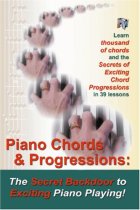Reharmonizing the 12 Bar Blues On The Piano
Reharmonizing the 12 Bar Blues
Good morning, this is Duane. Today I’d like to talk about Reharmonizing the 12 Bar Blues. Let’s take a quick review of the what the 12 Bar Blues is. 12 bars, of course, means 12 measures, and here’s the pattern, let’s say you’re playing in the Key of “F”. The Key of “F” means you’re basically, you’re playing on the scale of “F”. The blues usually uses a seventh chord. In other words, there’s the “F” chord, which is known as the one chord, but we put a seventh in when we play the blues, most of the time.
We have the one chord, and then we’ve got the four chord, which is “B” flat in the key of “F”, and that usually has a seventh in it like that. Then we have the five-seven chord. There’s three chords that we use repeatedly in the blues. Let me play through it without, play the 12 Bar Blues one time through without any reharmonization. See, we played through the 12 bar, 12 measures just using the one chord, the four chord, and the five chord, but usually with sevenths embedded in them.
Let me talk about reharmonization. You can reharmonize the blues to make it sound a little more interesting, and put your own stamp on it. In other words, bring your own personality out. I’m going to play the blues this time, but this time I’m going to use some reharmonization techniques.
Let talk about what those are. I played the one chord, and notice how I’m placing the left hand I put the seventh on the bottom, then the ninth, the third and the sixth, so I’ve got kind of a color tone there. Then what I did was I simply went up a half a step. I’m taking that chord, that “F” seventh chord, and I’m going up a half a step to we can call it “G” flat seventh, or “F” sharp seventh, anyway, it’s just a half step higher than playing the “F” seventh chord. Then I went up to the “B” flat chord. I did the same thing there. I played the “B” flat seventh chord with the seventh on the bottom. There’s the seventh, the root, the ninth, the third, and the fifth. You could play sixth up there, I guess.
Then I went up a half step from that, which would be the equivalent of “B” seventh, then back to “B” flat, and then I went back to “F”. Then I went like this, something like this. Really I’m staying on the “F” chord, but I’m walking up from “F” through “G” minor seventh, through “A” flat diminished to “F” seventh. Then before I went to the “B” flat chord I did a half step slide. In other words, what chord is a half step above “B” flat, I made it to “B” flat. I played “B” seventh of some sort. The way I voiced was “B”, “A”, right hand “C” sharp, “D” sharp, and “F”. Then landed on the seventh again.
There I went like this. “F”, went to “E” flat, and then I play “D” seventh with a flat third, that’s the “D” seventh chord there, but I’m putting not a third, but a flat third on top to give it a little more of a bluesy sound. Then I went the “D” seventh often leads to the “G” seventh, and that’s where I went, then back to “C” seventh.
If you use just those substitutes, a half step up from the basic chords, you can get some unique sounds. There’s many, many other things you can do, but that’s just an idea or two about how you can add a form of reharmonization to the 12 Bar Blues.
Thanks for being with me, and we’ll see tomorrow with another little idea like this. If you haven’t already come up, come over and sign up for our free newsletter, and videos, and so on. Please come over to playpiano.com and sign up. Thanks and we’ll see you tomorrow, bye.
Click on this link to watch this video on YouTube: https://www.youtube.com/watch?v=0T9qE49CiHA
***For lots more good stuff on piano playing come on over to my website at https://www.playpiano.com and sign up for our free piano tips – “Exciting Piano Chords & Sizzling Chord Progressions!”
Here’s a great little book on chords and chord progressions on Amazon: http://www.amazon.com/Piano-Chords-Chord-Progressions-Exciting-ebook/dp/B0076OUGDE/ref=sr_1_1?s=books&ie=UTF8&qid=1404158669&sr=1-1&keywords=piano+chords+duane+shinn
ÂÂÂÂÂÂÂÂÂÂÂÂÂÂÂÂÂÂÂÂÂÂÂÂÂÂÂÂÂÂÂÂÂÂ____________________________________________________________________________________




